
Original Link: https://www.anandtech.com/show/2140
ASUS P5N-E SLI: NVIDIA's 650i enters with a Bang
by Gary Key on December 22, 2006 5:00 AM EST- Posted in
- Motherboards
NVIDIA introduced the 680i chipset back in early November with eager anticipation from users looking to try something different within the Intel chipset world. There was a lot of hype, fanfare, and a great deal of media coverage that surrounded the launch of the NVIDIA 600i family of chipsets. We reviewed the 680i chipset in-depth at launch and came away very impressed with its capabilities for the upper-end enthusiast. Since the launch, most of the focus surrounding the 680i chipset changed from its impressive performance and flexibility to issues that seemed to plague the reference board designs from the launch partners such as EVGA and BFG. These issues revolved around audio issues when using SLI and data corruption or performance loss when utilizing SATA drives on the reference boards. The audio issues were solved with a quick BIOS update although we found in our testing that loading the Microsoft DX9 October update before the audio drivers also solved the issue. The data corruption on drives was an entirely different issue that seemed to be centered on users with RAID arrays but also spread to single drive users under varying circumstances.
A revised BIOS was introduced this past week that has apparently cured the majority of data corruption issues with the reference boards - an issue we did not witness in our testing of the ASUS 680i motherboards or with our own EVGA motherboards. While NVIDIA attributes the problems to signal timings on the motherboard, we are still investigating NVIDIA's claims about why the issue occurs on one board and not the other. NVIDIA has commented that statistical variations in the electrical paths between each board can vary and result in one board being affected and another one not. We know from the board manufacturers that this chipset is very sensitive to electrical noise and is one of the main reasons why a specific set of voltages is required to reach the upper overclock limits of the board. This specific set of voltage settings seem to differ from board to board and our initial opinion about this issue is based upon us having a "tolerant" MCP/SPP combination on our review boards.
We are about finished with our testing of several 680i boards and will have a full review up in the near future but at this time we are glad NVIDIA has come up with a fix. At the same time, these types of problems are not something people want to see in a top-end enthusiast chipset, and a bit more testing and validation in the future before launch might be a better solution than BIOS patches after the fact.
Since our first look at the 680i chipset we along with our readers have wondered when the lower priced 650i family of chipsets would arrive and more importantly how they would perform. ASUS is first to market with the NVIDIA 650i SLI chipset and we will see other manufacturers utilizing this chipset in January. The base 650i Ultra boards should be arriving in late January or early February. The 650i SLI was designed to offer dual x8 SLI operation, provide competitive performance to the Intel P965, and do this for a price in the $125~$175 range. The $64,000 question is if NVIDIA succeeded in designing a competitive chipset when compared to the Intel P965. We will provide some initial performance results today that should help in determining if ASUS' implementation of this chipset offers some serious competition or if we need to wait on additional motherboards before coming to a conclusion.
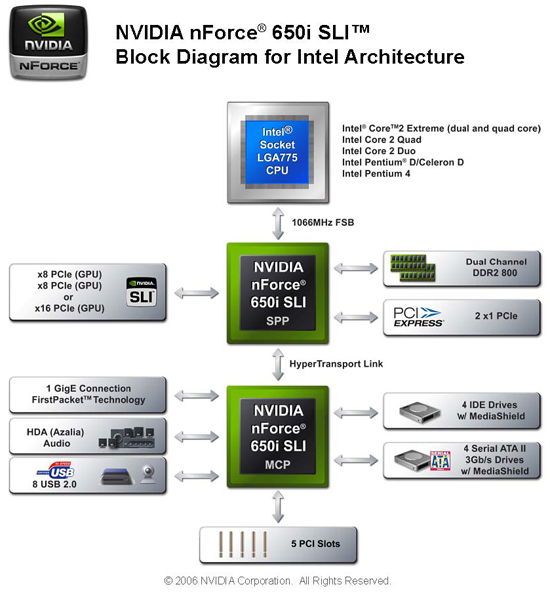
NVIDIA has designed the 650i SLI as their true mainstream performance chipset, given the 680i is targeted to the upper end performance segment with pricing starting around $230 compared to $130 for the 650i. Details about the differences between the two chipsets can be found here. The major highlights are the 650i only supports dual x8 SLI operation, single Gigabit Ethernet, four SATA 3Gb/s ports, and eight USB 2.0 ports instead of the dual x16 SLI, physics card slot, dual Gigabit Ethernet with teaming, six SATA 3Gb/s ports, and ten USB 2.0 ports on the 680i. Although NVIDIA has not stated specific support for the upcoming 1333FSB processors in the 650i, ASUS is saying the board will be capable of supporting them with an updated BIOS release. We also noticed that ASUS included EPP memory capability along with LinkBoost technology, both items are not officially supported by NVIDIA in their product documentation although each feature did work as advertised.
This leads us into today's performance preview of the ASUS P5N-E SLI. In our article today we will briefly go over the board layout and features, provide a few important performance results, and discuss our issues with the board. We will provide a further review of this product once we receive additional 650i based boards in January. With that said, let's take a look at where this board stands now.
ASUS P5N-E SLI Basic Features
| ASUS P5N-E SLI | |
| Market Segment: | Mid-Range Performance - $129.99~$149.99 |
| CPU Interface: | Socket T (Socket 775) |
| CPU Support: | LGA775-based Pentium 4, Celeron D, Pentium D, Pentium EE, Core 2 Duo, Core 2 Extreme |
| Chipset: | NVIDIA 650i SPP (C55) + 650i MCP (nF430) |
| Bus Speeds: | Auto, 533 to 3000 QDR in 1MHz increments |
| Memory Ratios: | Auto, Sync, 1:1, 5:4, 3:2 |
| Memory Speed: | 400MHz~2600MHz in various increments |
| PCIe Speeds: | 100MHz~131MHz in 1MHz Increments |
| Core Voltage: | Auto, .83125V to 1.60000V in 0.00625V increments |
| Core Voltage Offset: | Disable, +100mV |
| CPU Clock Multiplier: | Auto, 6x-11x in 1X increments if CPU is unlocked, downwards unlocked, Core 2 Duo |
| DRAM Voltage: | Auto, 1.920V ~ 2.517V in various increments |
| DRAM Timing Control: | Auto, 13 DRAM Timing Options |
| NB Voltage: | Auto, 1.208V, 1.393V, 1.563V, 1.748V |
| Memory Slots: | Four 240-pin DDR2 DIMM Slots Dual-Channel Configuration Regular Unbuffered Memory to 8GB Total |
| Expansion Slots: | 2 - PCIe X16 (2 - x8 electrical for SLI or Multi-GPU) 1 - PCIe x1 2 - PCI Slot 2.2 |
| Onboard SATA/RAID: | 4 SATA 3Gbps Ports - 650i MCP (RAID 0,1, 0+1, 5, JBOD) 1 e-SATA 3Gbps Port - JMicron JMB361 |
| Onboard IDE: | 2 ATA133/100/66 Port (4 drives) - 650i MCP |
| Onboard USB 2.0/IEEE-1394: | 8 USB 2.0 Ports - 4 I/O Panel - 4 via Headers 2 Firewire 400 Ports by VIA VT6308 - 1 I/O Panel, 1 via Header |
| Onboard LAN: | Marvell Gigabit Ethernet - PCI Express - 88E1116 PHY |
| Onboard Audio: | Realtek ALC883 - 6-channel HD audio codec |
| Power Connectors: | ATX 24-pin, 4-pin EATX 12V |
| I/O Panel: | 1 x PS/2 Keyboard 1 x PS/2 Mouse 1 x Parallel Port 1 x e-SATA 1 x S/PDIF Coaxial - Out 1 x IEEE 1394a 1 x Audio Panel 1 x RJ45 4 x USB 2.0/1.1 |
| BIOS Revision: | Award 0101 |
| Board Revision: | 1.01G |
ASUS follows a trend they started in the P5N series of boards by offering a moderate level of BIOS options for tweaking the board, with significant emphasis placed on the available memory settings. We found in memory testing that switching to manual settings and changing the tCAS, tRCD, tRP, tRAS, and command timing rate was required in order to maintain stability as our overclocking tests will show shortly. The board also features ASUS' AI overclocking system that will intelligently overclock the system based upon CPU load or off predetermined settings. This system generally overclocked the board between 7%-11% and is designed for users who want a little extra performance without worrying about adjusting multiple BIOS settings in order to tune the board.
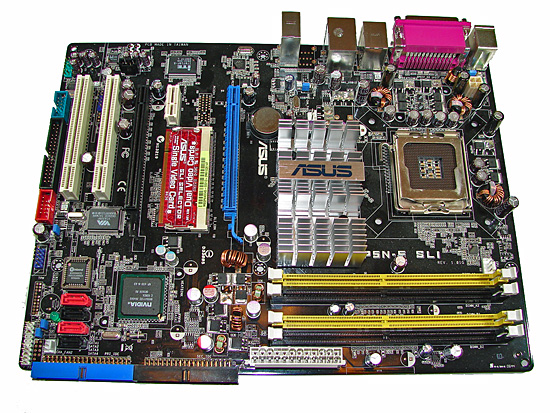 |
| Click to enlarge |
The board layout that ASUS devised for this chipset is actually quite good and we are glad to see the standard mustard color ASUS uses on their base boards has been banished from this design. The board features a very good three-phase power design and high quality capacitors. There are three fan headers located in easy to reach positions on the board, and they are easily controlled through ASUS' AI Suite or Speedfan. The board installed without issues into several cases and cable management was very good for both power and the optical/hard drives. The floppy drive connector is located at the bottom of the board and could present an issue for larger cases where the enclosed cable is not able to reach the floppy drive. The area around the CPU is slightly cluttered but we had no issues fitting our larger air coolers on this board. However, installation was slightly difficult due to the two large capacitors located in the upper right hand corner of the CPU mounting points.
The PCI Express and PCI slot arrangements are designed with multiple graphics card operation in mind, but this layout will mean the loss of a PCI slot if dual slot video cards are utilized. Like the original nForce4 SLI boards, this board requires the use of a paddle card to enable dual video cards. The C55 SPP is cooled by a large passive heatsink that worked fine up until we started overclocking above the 450FSB range, at which point it required an increase in voltage to 1.393V. We suggest a case with good airflow in it for this reason and the fact that the nF430 MCP is not cooled. We do not understand ASUS' decision to not cool the MCP unit with at least a small passive heatsink as this chipset tends to run hot during overclocking. Speaking of the nF430 MCP, it features four SATA 3Gb/s ports and two UltraATA 133 IDE ports that support up to four drives. This board offers a very good balance of SATA and PATA drive capability, and many users will welcome the return of dual IDE ports.
The audio subsystem is based on the Realtek ALC883 and offers 6-channel output. Realtek has had troubles recently with EAX 2.0 support but we did notice a slight improvement in the 1.51 driver set. However, the ADI 1988B HD audio codec that ASUS utilizes in their upper level boards still offers significantly better EAX audio quality in games than the Realtek HD codecs. ASUS includes the excellent VIA VT6308 IEEE 1394 controller along with the Marvell 88E1116 PHY for Gigabit Ethernet capability.
Test Setup
| Standard Test Bed Performance Test Configuration |
|
| Processor: | Intel Core 2 Duo E6600 (2.4GHz, 4MB Unified Cache) |
| RAM: | OCZ Flex XLC (2x1GB), 2.30V (Micron Memory Chips) |
| Hard Drive: | Western Digital 150GB 10,000RPM SATA 16MB Buffer Seagate 750GB 7200.10 7200RPM SATA 16MB Buffer |
| System Platform Drivers: | Intel - 8.1.1.1010 NVIDIA - 9.35, 8.26 ATI - 6.10 |
| Video Cards: | 1 x MSI X1950XTX , 2 x MSI 8800GTX for SLI testing |
| Video Drivers: | ATI Catalyst 6.11, NVIDIA 97.44 for SLI Testing |
| CPU Cooling: | Scythe Infinity |
| Power Supply: | OCZ GameXstream 700W |
| Optical Drive: | Sony 18X AW-Q170A-B2, Plextor PX-B900A |
| Case: | Cooler Master CM Stacker 830 |
| Motherboards: | ASUS Striker Extreme (NVIDIA 680i) - BIOS 0505 ASUS P5N-E SLI (NVIDIA 650i) - BIOS 0101 ASUS P5B-E (Intel P965) - BIOS 0601 DFI LANParty UT ICFX3200-T2R/G (AMD RD600) - BIOS 12/07 Intel D975XBX2 (Intel 975X) - BIOS 2333 |
| Operating System: | Windows XP Professional SP2 |
| . | |
A 2GB memory configuration is now standard in the AnandTech test bed as most enthusiasts are currently purchasing this amount of memory. Our choice of high-end OCZ Flex XLC memory from OCZ offered a very wide range of memory settings during our stock and overclocked test runs. We also utilized our Corsair XMS2 Dominator (Twin2x2048-9136C5D) memory on this board to verify DDR2-1066 compatibility with another memory type. We are currently testing several other memory modules ranging from TwinMOS DDR2-800 down to A-DATA DDR2-533 for compatibility and performance benchmarks. Our memory timings are set based upon determining the best memory bandwidth via MemTest 86 and test application results for each board. This includes optimizing the memory sub-timings to ensure each board performs at its absolute best.
We are utilizing the MSI X1950XTX video card to ensure our 1280x1024 resolutions are not completely GPU bound for our motherboard test results. We did find in testing that applying a 4xAA/8xAF setting in most of today's latest games created a situation where the performance of the system starts becoming GPU limited. Our video tests are run at 1280x1024 resolution for this article at High Quality settings. We also tested at 1600x1200 4xAA/8xAF for our NVIDIA SLI results on the two NVIDIA based boards. Although not reported, we also completed the same SLI tests at 1920x1200 4xAA/8xAF but did not report the scores as the performance delta between each board was the same as the 1600x1200 results.
All of our tests are run in an enclosed case with a dual optical/hard drive setup to reflect a moderately loaded system platform. Windows XP Pro SP2 is fully updated and we load a clean drive image for each system to ensure driver conflicts are kept to a minimum.
Overclocking
| ASUS P5N-E SLI Overclocking Testbed |
|
| Processor: | Intel Core 2 Duo E6600 Dual Core, 2.4GHz, 4MB Unified Cache 1066FSB, 7x Multiplier |
| CPU Voltage: | 1.52500V (default 1.3250V) |
| Cooling: | Scythe Infinity Air Cooling |
| Power Supply: | OCZ GameXStream 700W |
| Memory: | OCZ Flex XLC (2x1GB) (Micron Memory Chips) |
| Video Cards: | 1 x MSI X1950XTX , 2 x MSI 8800GTX for SLI |
| Hard Drive: | Western Digital 150GB 10,000RPM SATA 16MB Buffer Seagate 750GB 7200.10 7200RPM SATA 16MB Buffer |
| Case: | Cooler Master CM Stacker 830 |
| Maximum CPU OC: | 402x9 (4-4-4-12 1T, 804MHz, 2.34V), CPU 1.52500V 3622MHz (+51%) |
| Maximum FSB OC: | 502x7 (4-4-4-12 2T, 804MHz, 2.34V), CPU 1.50000V 3519MHz (+89% FSB) |
| . | |
We were easily able to reach a final benchmark stable setting of 9x402 FSB resulting in a clock speed of 3622MHz. The board was capable of running at 9x409 FSB but would consistently fail several of our game benchmarks. We attributed this overclock limit to the lack of proper cooling for our MCP and SPP at the voltages we set. We added additional fan cooling along with proper heatsink paste to the SPP and a small passive heatsink to the MCP unit and reached 9x417 before stability became an issue again. We believe this is near the limit of the CPU/chipset combination. Vdroop was terrible on this board during overclocking with an average drop of .06 ~.09V during load testing.

We operated our memory at 4-4-4-12 1T with all sub-timings set at Auto for a final speed of 804MHz. We could not get the board stable with CAS 3 and 1T settings at DDR2-800. We were able to finally reach DDR2-1066 at 5-6-6-24 2T in a stable manner but the memory latencies were so lax that performance actually decreased in most benchmarks. The BIOS has the majority of memory sub-timings set very tight along with the SPP timings. We found this to be our issue with trying to operate memory at the higher speeds or utilizing lower latency settings. However, we have found this board performed extremely well with the 4-4-4-12 1T settings due to the aggressive sub-timings. We were able to run 4-4-4-12 2T timings up to around DDR2-880 but had to switch to 5-5-5-15 2T timings up to DDR2-1000, anything over that required very loose timings across all memory settings for stability.
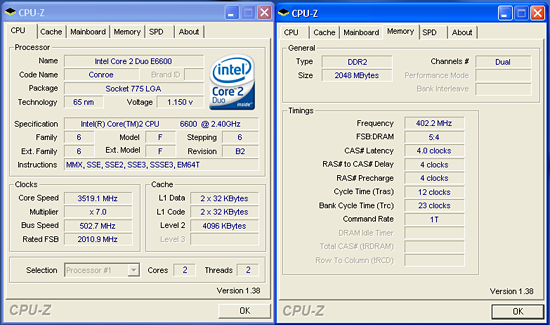
We dropped the multiplier on our E6600 to seven and were able to reach 502 FSB without an issue. We were able to enter XP at 7x509 and the board would post at 7x519. However, at least with our sample, stability over 504FSB dropped off quickly and we feel like the board was designed with 500FSB in mind but not much more. We have seen user results that are around 480~506FSB with and without additional cooling so we feel confident that our review sample is not "special". We have a full retail kit arriving and will verify our results against it. We will also utilize the retail kit when we have other 650i SLI boards to review. Overall, the overclocking capability surprised us as we initially expected this chipset to be closer to a maximum bus speed of around 450 FSB.
General Application Performance
 |
| Click to enlarge |
The performance of the board in our application benchmarks was good and the board seemed a bit more responsive than the 680i, although the benchmarks were a tossup. While not directly competitive with the Intel P965 in our Nero Recode Test, we did find the board to perform consistently close in our full application benchmark test suite that includes audio/video benchmarks not listed in our preview. However, our 975X and P965 chipsets still offer the best overall performance.
In our Nero Recode test we consistently found the performance of the 680i/650i to be lacking due to disk access issues. The conversion process would consistently slow down while the disk was being accessed. The quality of the video conversion was not affected but it appears under heavy CPU usage that disk performance suffers at this time with both NVIDIA chipsets.
Synthetic Graphics Performance
The 3DMark series of benchmarks developed and provided by Futuremark are among the most widely used tools for benchmark reporting and comparisons. Although the benchmarks are very useful for providing apple to apple comparisons across a broad array of GPU and CPU configurations they are not a substitute for actual application and gaming benchmarks. In this sense we consider the 3DMark benchmarks to be purely synthetic in nature but still very valuable for providing consistent measurements of performance.
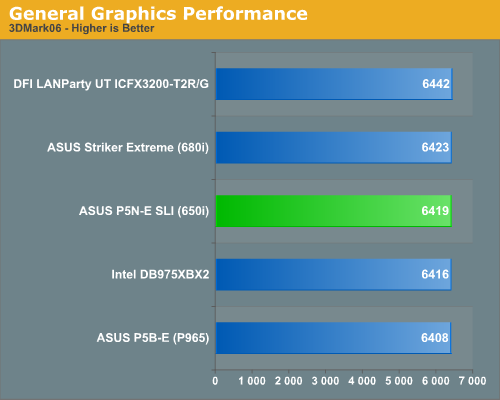

In our 3DMark06 test, each platform score is basically the same although we see the DFI RD600 based motherboard leading slightly. We attribute this slight difference to the automatic overclocking of the PCI Express graphics slot to 125MHz with our ATI X1950XT. This feature is included in the LinkBoost technology featured on the NVIDIA 680i motherboards when utilizing an approved NVIDIA graphics card. In the more memory and CPU sensitive 3DMark01 benchmark we see the Intel 975X board pulling away from the other boards due to its superior memory bandwidth at stock settings. Even though this holds true to some degree for the ASUS P5B-E based on the P965 chipset, we see it scoring slightly lower than our NVIDIA solutions due to relaxed MCH timings that allow it to excel in overclocking with FSB rates consistently hitting 520+. Although our reported Sandra memory bandwidth scores along with Memtest86 testing consistently show the RD600 performing better than the 680i or 650i, our 3D01 benchmark is not showing this advantage. NVIDIA based chipsets perform very well in graphics tests and the scores from our Intel DB975XBX2 indicate a highly tuned system.
General System Performance
The PCMark05 benchmark developed and provided by Futuremark was designed for determining overall system performance for the typical home computing user. This tool provides both system and component level benchmarking results utilizing subsets of real world applications or programs. The benchmark is useful for providing comparative results across a broad array of Graphics subsystems, CPU, Hard Disk, and Memory configurations along with multithreading results. In this sense we consider the PCMark benchmark to be both synthetic and real world in nature while providing consistency in our benchmark results.
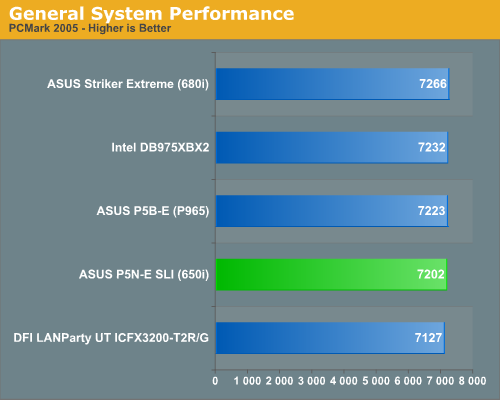
The ASUS 650i is competitive in this benchmark although we expected slightly better performance based upon our other scores. The 650i and 680i scored very well on the single task disk benchmarks and both performed almost equally on the graphics subsystem tests where they led the field. However, our 975X and P965 chipset boards won the multitasking tests while the RD600 finished in the middle on most of the tests.
Standard Gaming Performance
As usual, gaming performance was tested with a variety of current games. We ran benchmarks with our standard 1280x1024 resolution without antialiasing enabled (and generally without anisotropic filtering, though that varies by game). Given the number of users that run 19 inch LCDs these days, 1280x1024 represents one of the most commonly used resolutions. We could certainly increase the amount of eye candy being displayed in most of the games, but as this is a motherboard benchmark we aren't particularly interested in maxing out the graphics cards in our tests.
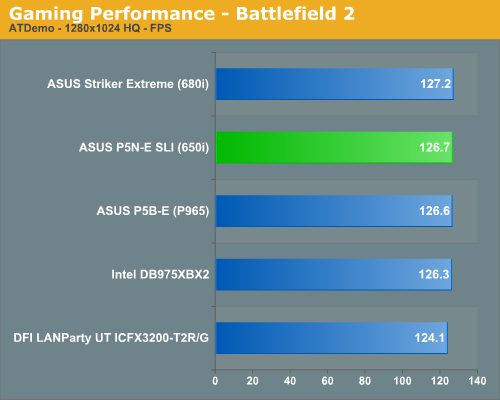
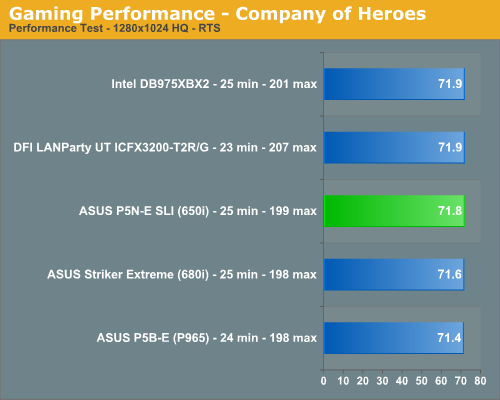
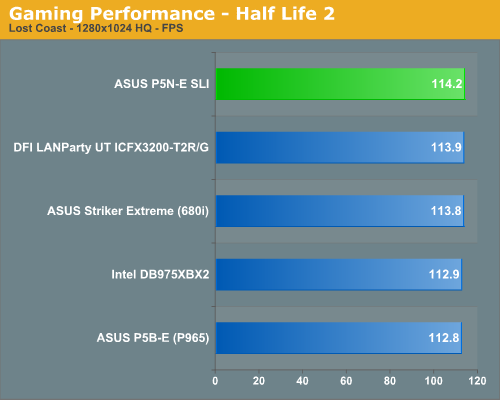

These results surprised us but after testing several other games we came to the same conclusion, the ASUS P5N-E SLI performs extremely well in our game benchmarks where graphics subsystem optimizations are very important. The board was very stable with our settings and did not have any issues during benchmarking or online game play. However, this board was ultra sensitive to memory changes when testing games. Although we could dial in higher memory speeds or lower latencies and still pass the synthetic tests, we would notice instant lockups in games with the same settings. We received a retail Intel DB975XBX2 board that performed slightly better than our press kit sample during testing and will update these scores in our next RD600 article. While the performance improved, especially in CrossFire operation, it did not improve enough to top the 650i board.
High-Resolution Gaming Performance
For high-quality gaming performance, we also tested at 1600x1200 and 1920x1200 with 4xAA /8xAF. As just about anyone familiar with current games can tell you, benchmarking with most single high-end graphics card at those stressful settings will make just about any recent game GPU limited. In fact, several of the most recently released games such as Oblivion can be GPU limited at this setting even with CrossFire or SLI setups. However, our testing will utilize the GeForce 8800 GTX and unfortunately, the two games we listed do not benefit that much from SLI. This is due to both our processor choice and the fact the current drivers still need additional SLI optimizations. In fact we did not see any real differences in performance in Q4 or Battlefield 2 with SLI enabled. Our initial testing with Oblivion did show improvements but we still believe our 8800 GTX SLI combination was CPU limited in most of our tests.
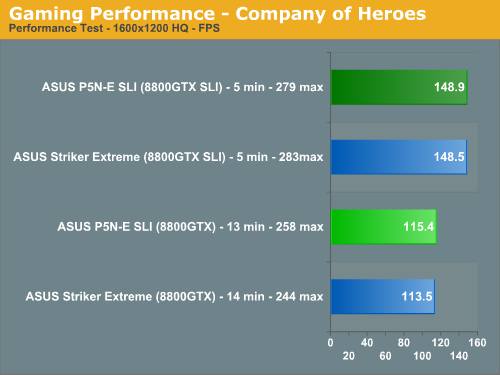
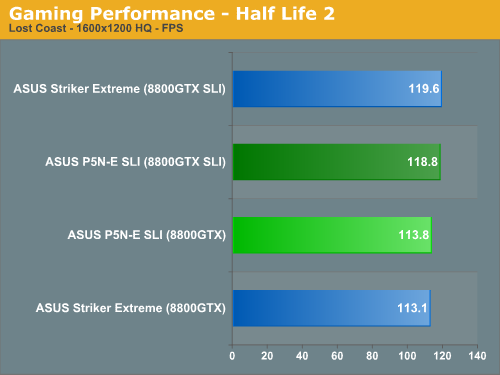
We had heard rumors that the 8800 GTX cards would thrive on the dual x16 capable 680i chipset but in looking at the results in our two test games it appears there is very little difference in the scores between the two nForce 600i boards. We did not have any issues running our 8800 GTX SLI setup on the dual x8 capable 650i board and only in the synthetic 3DMark benchmarks did we see any true separation between the two setups. Those results favored the 680i over the 650i by 8% in 3DMark06, 6% in 3DMark05, and in 3DMark 2001 the 650i actually finished about 4% ahead of the 680i. At this time, the current games we have tested will perform almost equally on either board in 8800 GTX SLI operation at 1600x1200. We also tested at 1920x1200 resolutions with the same results between the two chipsets. We still need to complete testing at 2560x1600 with the 650i chipset but considering the very small increase in performance in SLI mode with our test setup, we highly recommend the purchase of a single 8800 GTX for today's games and to forgo 8800 GTX SLI operation at this time.
Disk Controller Performance
The AnandTech iPeak test is designed to measure "pure" hard disk controller performance, and in this case we keep the hard drive as consistent as possible while varying the hard drive controller. The idea is to measure the performance of each hard drive controller with the same hard drive.
We played back our raw files that are recorded I/O operations when running a real world benchmark - the entire Winstone 2004 suite. Intel's iPeak utility was then used to play back the trace file of all I/O operations that took place during a single run of Business Winstone 2004 and MCC Winstone 2004. To try to isolate performance differences to the controllers that we are testing we are using the Western Digital 74GB Raptor with 16MB cache for both our standard disk controller and RAID performance tests for this article. The drive is formatted before each test run and a composite average of three tests on each controller interface is tabulated in order to ensure consistency in the benchmark.
iPeak gives a mean service time in milliseconds; in other words, the average time that each drive took to fulfill each I/O operation. In order to make the data more understandable, we report the scores as an average number of I/O operations per second so that higher scores translate into better performance. This number is somewhat meaningless as far as hard disk performance is concerned, as it is just the number of I/O operations completed in a second. However, the scores are useful for comparing "pure" performance of the storage controllers in this case.
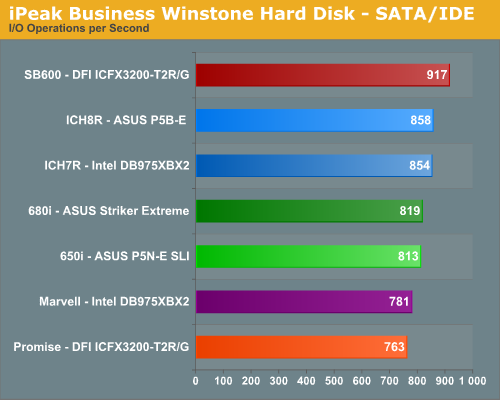

The performance patterns hold steady across both Multimedia Content I/O and Business I/O with the SB600 outperforming the Intel ICH7R, Intel ICH8R, and NVIDIA 680i/650i chipsets in our non-RAID tests. The Promise controller on the DFI board is the slowest of all solutions with the Marvell controller on the Intel 975X performing only slightly better. The 680i and 650i MCP units are different but their disk performance in our tests is basically alike. We also ran RAID 0 and RAID 5 tests on each controller with the results being in favor of the 680i MCP by around 2%. We did not witness any data corruption on either ASUS NVIDIA based board as has been reported on the 680i reference boards (though this is apparently now fixed with the latest BIOS updates).
Power Consumption
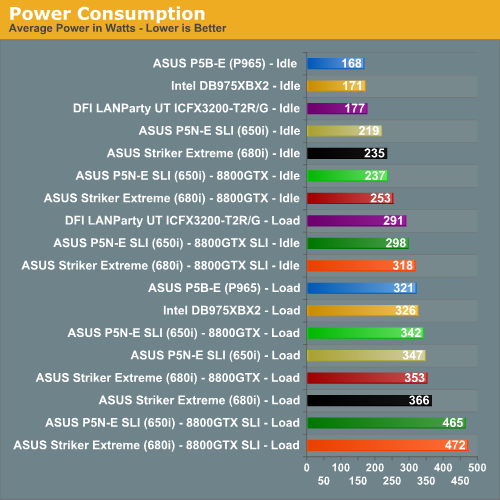
Our power consumption numbers are based on our test setup for this article that consists of the MSI X1950XT video card. We tested our 650i and P965 based boards with the same setup in our previous tests. We also added results with the 8800 GTX in single card and SLI configurations on the 650 and 680i boards. The 680i leads all boards in power consumption but the 650i SLI is second; on average it consumes about 7% less power than the 680i at idle and 3% less at load. The P965 consumes the least amount of power at idle but around 10% more than the RD600 at load.
First Thoughts
Once again we have to ask the $64,000 question: did NVIDIA succeed in designing a competitive chipset when compared to the Intel P965? Our answer to that question is a very reserved yes. While the chipset was very competitive in the majority of our early benchmark results, we have to wonder if this is due to the ASUS implementation or if our results indicate the actual strength of the chipset. Until we are able to test more motherboards based on this chipset it will be difficult to give a final answer. We have some hunches however and believe the chipset is competitive but certainly does not deliver a knockout blow to the P965.
Our initial thoughts are based upon how sensitive the board is to memory timing changes and types of memory utilized. We found the memory and chipset timings are tweaked very tightly resulting in a very narrow band of settings that are stable. We have discussed our memory timing issues with ASUS several times and currently we are awaiting a full response. While this is a drawback to the board, if you have memory capable of running at 4-4-4-12 1T at DDR2-800 then this board offers excellent gaming performance and very good application performance. ASUS can be congratulated for getting excellent results in the game and synthetic benchmarks, but it appears to be at the expense of memory compatibility. Of course, P965 also had quite a few issues with memory compatibility when it first launched, so perhaps NVIDIA and the board manufacturers just need a bit more time to become acquainted with the needs of the chipset.(Update - ASUS will be providing a Beta BIOS early next that addresses our memory timing issues.)
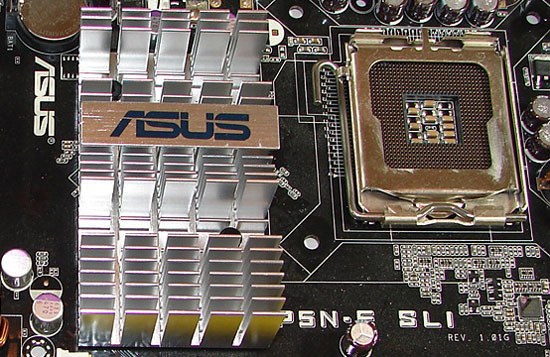
We have tested the board for over a week now with a wide variety of components in several different configurations. The board has proved to be extremely stable and performs very well when the right memory settings are applied. We still have significant testing left to complete once our retail kit arrives, but at this time we really like the chipset and the motherboard. The performance of the board and the fact it has a decent set of features leaves us wondering why we would spend over a $100 more for the 680i boards. Sure, the 680i boards have additional features such as dual Gigabit Ethernet connections with DualNet technology, dual x16 graphics slots along with a slot designed for physics capability, an additional two SATA 3Gb/s and USB 2.0 ports, and enhancements like LinkBoost, SLI Ready Memory, and extended overclocking capabilities. However, does every user need these additional features?
We think not, and we believe the 650i SLI chipset offers basically the same or better performance as the 680i about 95% of the time for significantly less money. It may turn out that this chipset isn't so much of a P965 killer but instead is a 680i killer in most cases. This is actually good news as this chipset was designed for the mainstream performance market and the 680i really is meant for the small but very vocal enthusiast sector. Coming back to the P965, we found the 650i SLI offered similar performance in most cases and excelled in gaming where its main purpose in life exists.
The advantages the 650i SLI offers is official SLI support, native IDE chipset capability along with support for four IDE devices, flexible memory and FSB settings, and a similar price to performance ratio when compared to the P965. The main negatives we see are increased power consumption, memory bandwidth is lower overall, and FSB overclocking is comparatively lower (although the true capabilities of the chipset are not yet fully known)than the upper end P965 motherboards.
In many ways that's the biggest concern at this time: the unknown. We do not know how this chipset will perform when utilized in other board designs and what the average cost for the board will be in the near future. We have seen the ASUS P5N-E SLI offered for around $129.99 and at that price with the right set of memory, we think it is a great bargain, especially if you plan on running an SLI setup or have multiple IDE devices still in use. We still have a lot of questions about this chipset and motherboard, too many to pass final judgment on either one at this time, but we will report back in the near future with additional test results and hopefully a look at several other new boards based on the 650i SLI chipset. We think this chipset has a bright future in the mainstream performance market and believe ASUS has, at first look, designed a very good board around it.







